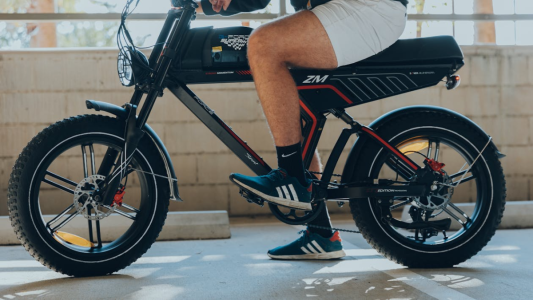Remember when bikes were built for safety—not speed? One company is sounding the alarm
By
Maan
- Replies 1
Electric bikes were once seen as the future of clean, fast transport—but now, experts say a growing black market is threatening to derail the entire industry.
Across Australia’s biggest cities, riders are zipping through traffic on illegally modified bikes that can hit speeds of up to 60 km/h.
Now, a leading e-bike manufacturer is urging the government to crack down before someone gets seriously hurt.
The surge in unregulated e-bike usage has left manufacturers like Zoomo frustrated as they struggle to compete with illegal alternatives.
Zoomo’s operations manager, Gema Martínez Casanova, said her team worked hard to deliver a safe, legal product—only to be undercut by riders chasing speed.
‘It’s quite frustrating because we try to create a really safe and reliable product for our customers,’ she said.
She added that the bad behaviour of some riders was giving all e-bike users a bad name.
‘We understand e-bikes, there’s a big increase in usage with e-bikes, and there are a lot of people who don’t like them because they have this idea of e-bikes going 45 km/h on the pathway.’
Unlike cars or motorcycles, legal e-bikes in Australia don’t require registration or a licence—as long as they remain within approved specifications.
Under the European Standard EN15194, which applies in most states and territories, electric motors must not exceed 250 watts and must cut off once the bike hits 25 km/h.
But many delivery workers—keen to complete more jobs per hour—have started using modified or imported models that exceed these limits.
Some even retrofit regular bicycles using widely available conversion kits, which can push speeds above 60 km/h and power levels beyond 1000 watts.
‘We can’t do anything, because the customer wants to make more deliveries per hour, so of course they are going to go for a vehicle that goes faster,’ Martínez Casanova said.
‘So not only do we have to compete by always trying to be better on our hardware and customer experience on a legal side, but also we have to be aware of the illegal bikes in the industry.’
‘We really respect the law, but we would like everyone to be applying the same rules.’
‘We create such a safe, reliable product, and we also employ a lot of people in Australia, but at the end of the day, we won’t be able to compete.’
She said the issue was visible on streets every day.
‘We urge the authorities to do more on illegal e-bikes. We see it everyday when a rider is riding up hill, not pedalling and travelling more than 6km per hour.’
The Victorian Automotive Chamber of Commerce (VACC) also called for urgent enforcement of national regulations under the Road Vehicle Standards Act.
CEO Peter Jones said illegal bikes were being used for commercial purposes and should be subject to the same rules as other business vehicles.
‘It’s one thing to ride a compliant e-bike recreationally,’ he said.
‘But when you’re using a 1000-watt machine all day in city traffic to deliver for a company, you’re operating a commercial vehicle. That must come with legal responsibilities, just like it would for a van, a ute or a motorbike.’
In New South Wales, police have launched high-visibility operations to clamp down on tampered bikes.
One campaign, Operation Kilowatt, inspected 305 bikes over a month and found 28 had been illegally modified.
Officers issued 32 fines, and checks have continued in high-traffic zones like the Sydney CBD, Byron Bay, and the Eastern Suburbs.
If the rise of illegal, high-speed e-bikes has you thinking twice about what’s really safe on the roads, there’s another concern that’s just as alarming—hidden fire hazards.
Some electric models have recently been pulled from shelves due to serious battery risks, prompting urgent safety warnings for anyone who owns one.
It’s a reminder that even legal e-bikes can come with unexpected dangers if they aren’t built—or maintained—properly.
Read more: Fire risk recall: These e-bikes just got pulled—check yours now!

What would it take for authorities to start treating high-speed e-bikes like the powerful machines they’ve become?
Across Australia’s biggest cities, riders are zipping through traffic on illegally modified bikes that can hit speeds of up to 60 km/h.
Now, a leading e-bike manufacturer is urging the government to crack down before someone gets seriously hurt.
The surge in unregulated e-bike usage has left manufacturers like Zoomo frustrated as they struggle to compete with illegal alternatives.
Zoomo’s operations manager, Gema Martínez Casanova, said her team worked hard to deliver a safe, legal product—only to be undercut by riders chasing speed.
‘It’s quite frustrating because we try to create a really safe and reliable product for our customers,’ she said.
She added that the bad behaviour of some riders was giving all e-bike users a bad name.
‘We understand e-bikes, there’s a big increase in usage with e-bikes, and there are a lot of people who don’t like them because they have this idea of e-bikes going 45 km/h on the pathway.’
Unlike cars or motorcycles, legal e-bikes in Australia don’t require registration or a licence—as long as they remain within approved specifications.
Under the European Standard EN15194, which applies in most states and territories, electric motors must not exceed 250 watts and must cut off once the bike hits 25 km/h.
But many delivery workers—keen to complete more jobs per hour—have started using modified or imported models that exceed these limits.
Some even retrofit regular bicycles using widely available conversion kits, which can push speeds above 60 km/h and power levels beyond 1000 watts.
‘We can’t do anything, because the customer wants to make more deliveries per hour, so of course they are going to go for a vehicle that goes faster,’ Martínez Casanova said.
‘So not only do we have to compete by always trying to be better on our hardware and customer experience on a legal side, but also we have to be aware of the illegal bikes in the industry.’
‘We really respect the law, but we would like everyone to be applying the same rules.’
‘We create such a safe, reliable product, and we also employ a lot of people in Australia, but at the end of the day, we won’t be able to compete.’
She said the issue was visible on streets every day.
‘We urge the authorities to do more on illegal e-bikes. We see it everyday when a rider is riding up hill, not pedalling and travelling more than 6km per hour.’
The Victorian Automotive Chamber of Commerce (VACC) also called for urgent enforcement of national regulations under the Road Vehicle Standards Act.
CEO Peter Jones said illegal bikes were being used for commercial purposes and should be subject to the same rules as other business vehicles.
‘It’s one thing to ride a compliant e-bike recreationally,’ he said.
‘But when you’re using a 1000-watt machine all day in city traffic to deliver for a company, you’re operating a commercial vehicle. That must come with legal responsibilities, just like it would for a van, a ute or a motorbike.’
In New South Wales, police have launched high-visibility operations to clamp down on tampered bikes.
One campaign, Operation Kilowatt, inspected 305 bikes over a month and found 28 had been illegally modified.
Officers issued 32 fines, and checks have continued in high-traffic zones like the Sydney CBD, Byron Bay, and the Eastern Suburbs.
If the rise of illegal, high-speed e-bikes has you thinking twice about what’s really safe on the roads, there’s another concern that’s just as alarming—hidden fire hazards.
Some electric models have recently been pulled from shelves due to serious battery risks, prompting urgent safety warnings for anyone who owns one.
It’s a reminder that even legal e-bikes can come with unexpected dangers if they aren’t built—or maintained—properly.
Read more: Fire risk recall: These e-bikes just got pulled—check yours now!
Key Takeaways
- Zoomo said illegal e-bikes were harming their business and reputation.
- E-bike conversion kits sold online can exceed 1000 watts and 60 km/h.
- Authorities in NSW have fined riders and confiscated modified bikes.
- VACC warned that commercial riders must follow existing road laws.
What would it take for authorities to start treating high-speed e-bikes like the powerful machines they’ve become?








